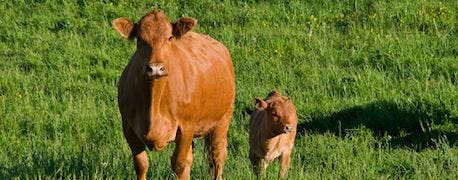
At $450 per cow-calf pair for the season, pasture leases in certain parts of Nebraska are enough to make a cattleman's jaw drop. It wasn't long ago that cropland leases, paired with high corn prices, were skyrocketing in the same way. "We couldn't stop those leases, they kept going up," says Allan Vyhnalek, University of Nebraska Extension educator. Now, he adds, "We can't stop pasture leases, because they're tied to the beef commodity. Leases are very aggressive, and we've got to remember what commodity we're tying this to."

NOW'S THE TIME: With grazing season right around the corner, and pasture leases paired with record-high beef prices, Allan Vyhnalek says now is the time to carefully lay out the provisions for this year's pasture lease agreements.
The evidence is most apparent just east of the Sandhills in Greeley, Valley, Garfield, and Wheeler counties. "That area for some reason is a really hot spot for pasture leases," Vyhnalek says. "People are talking $400, $450, up to $500 per pair for the grazing season."
Pasture lease provisions
With grazing season right around the corner, and pasture leases paired with record-high beef prices, Vyhnalek says now is the time to carefully lay out the provisions for this year's pasture lease agreements. These provisions should include:
• The rent itself. Is it per day, per month, or for the entire grazing season? Is it on a per acre or per cow-calf pair basis? In the eastern part of the state, pasture is usually rented on a per acre basis, like cropland. Out west in the Sandhills, where crop acres are few and far between, pasture is usually rented on a per pair basis.
• Clearly defined grazing season, whether from mid-May to mid-October in eastern Nebraska, or early June to early November in the Sandhills. This should also include penalties for early ins and late outs. In addition, stocking rate, the number of animals assigned to an area on a seasonal basis, or stock density the number of animals or animal live weight assigned to an area at a specific point in time, should also be clearly defined in the lease, keeping cow size and pasture conditions after the previous season in consideration.
~~~PAGE_BREAK_HERE~~~
• Tenants and landowners should have a clear understanding of responsibilities like weed control, whether regular noxious weeds, in which case the responsibilities usually fall in the hands of the tenant, or brush control for eastern red cedars or leafy spurge, usually the responsibility of the landowner. Other duties include fertilizer, which is often left to the tenant. Fence and infrastructure maintenance is usually across the board. If landowners choose to maintain their own ranch, the rent will probably be higher, and will likely be lower if the tenant is responsible for maintenance and repair.
• It's the responsibility of both landowner and tenant to monitor pasture forage growth, and it's important to include a disaster clause for what to do in the event of drought to keep grass from being grazed too short. In some cases, lease agreements include a third-party arbitrator whose responsibility is determining when it's time to pull livestock from the pasture.
• Keep disaster assistance programs in mind. Programs like FSA's Livestock Forage Program (LFP) require producers to show the risk in grazing pasture acres to receive payments. This means tenants must pay a monthly or seasonal rate to be eligible. It also means tenants who de-stock a pasture early due to drought must still pay for the full grazing season in order to remain eligible.
• Landowners should be clear about whether subleases for someone else's cows or hay are permitted. Hay is usually leased on a share basis, with the landlord receiving a share of the produced hay crop.
Communication is key
If the pasture is being grazed too short, there needs to be a two-way dialogue, and both parties should be paying attention to how short the grass is. "It's kind of a two-way street. You can't wait until it gets that bad," Vyhnalek says, noting an example of one landowner who didn't check a pasture until it had been grazed down to a dirt road. "That's a bad communication on both their parts. The tenant has to let the landowner know that pasture is in bad shape."
Communication also varies depending on the generation. For younger generations, communicating via text message with a picture of the pasture is sufficient. However, for older generations, communicating over the phone, or better yet, in person, may be preferred. Either way, it's important to make sure those discussions occur when pasture conditions require it. As Vyhnalek says, "Communication is key."
For more information, contact Vyhnalek at [email protected], or visit the UNL Beef website or aglease101.org.
About the Author(s)
You May Also Like






